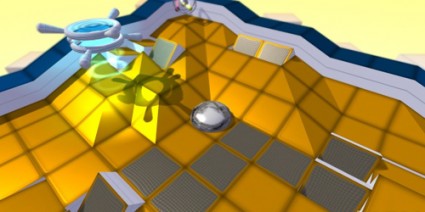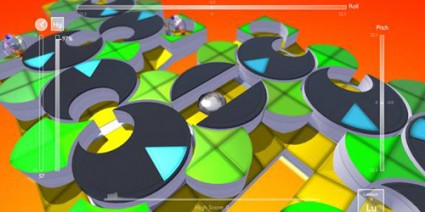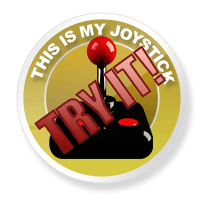Reviews
Review: Mercury Hg
October 6, 2011, Author: Trent Pyro
I was never any good at Science at school; I was always more into English and Drama. One thing I do remember, though, is mercury. Deadly to inhale and possessing mysterious properties, this odd silver liquid transcended the lab years ago and has been featured in many films and games in many different forms. Usually, though, these forms have been bombs or gadgets or even existential code-names. Mercury Hg, however, brings the shiny liquid to the forefront and tasks you with guiding it about.
Here’s the science bit!
Now, I knew nothing of Mercury (the game series, that is) until a few days ago, so a fellow TIMJ comrade had to fill me in on the background of the series. Apparently Mercury began on the PSP followed by a PS2 port. It was invented by Archer Maclean, who, despite sounding like a cartoon detective, actually masterminded the Jimmy White’s Snooker games.
Regarded as a niche title but considered to be one of the best the PSP had to offer in its early days, Mercury has now got a lick of HD paint and is floating around XBLA as we speak. Cheers for that James! So, is it any good?
Tilt-a-world
The basic concept is to guide a little blob of mercury around increasingly complex puzzle stages by tilting the actual stage itself. What begins as a simple slip and slide around a basic, walled platform quickly becomes a tense balancing act as you attempt to avoid pitfalls, blob-splitting arrows and many other traps and obstacles. Your goal is to work your way through all 118 elements, discovering new atomic structures as you go. Discovery mode, as it’s called, presents you with the full periodic table instead of a level select or map screen, which is a nice touch.
Colour also features quite prominently in the levels. Beams of different coloured light adorn the stages and passing the mercury underneath them will turn it that colour. Coloured tiles can only be passed over by a blob of that colour and some switches are colour-coded too. This gets more complicated as well, when you later have to split your blob in two and combine two colours to make a third. Being colour blind, this was sometimes tricky for me, but the bold primary colours and simple mixtures weren’t too hard to figure out and will be a cinch for someone who sees colour normally.
In every stage you’re aiming to hit four targets. The first is your amount of mercury; stray too close to an edge or let a little globule go A.W.O.L. and you’ll lose liquid. As long as there’s mercury on the board you can still finish but you’ll fail this first target. Second is a very strict time limit, which is offset by the third target of collecting all the atoms littered around the stage. The fourth is simply finishing the stage and is the only one that’s impossible to miss. For each target met you get an atom. Once you collect enough you unlock the next set of stages or ‘atomic structure’.
While it’s easy to hit all the targets in the first few levels, it soon becomes clear that every stage is meant to be played at least twice. You have to make a choice when you begin; crack the time limit or grab the atoms. Few levels allow you to do both without great difficulty, and many make it almost impossible. I’m sure there’s Mercury experts out there who could easily beat the time and grab all the atoms in one go but the rest of us are gonna have to choose. The general difficulty climb is also poor; easy rides are proceeded by crushingly difficult tests of pinpoint-accurate skill. There seems to be no pattern to the toughness of the levels, which I suppose keeps you guessing but is immediately an obstacle.

What starts off relatively simple quickly turns into a nightmare...
Challenge mode allows you to play clusters of stages with overarching goals. For instance, keeping 75 percent of your mercury and grabbing at least 8 atoms over 4 stages. These start out relatively doable but almost instantly become fevered feats of Mercury expertise. Even with the modest skill I’ve developed over a few days of play some of the clusters are next to impossible. Certainly one for the hardcore then.
Equally taxing in their own way are the Bonus stages. These are unlocked by performing well in the standard Discovery stages and are all about keeping your mercury safe. Starting with around 50 percent, you have to carefully slide around the level collecting vials to boost your blob size. Only once you have 100 percent can you slop to the finishing square. With no time limit or atoms to collect, at first it seems quite sedate and relaxed, the completion time a nice little indication of how nifty you are. That is, until you spot the leaderboards.
Everything in Mercury Hg is rated and posted. Be it completion time, remaining time or atoms collected, every stage ends with your score being uploaded and a brief display of the leaderboards. I can’t decide if this is positive or not; it’s great for those competitive players out there who want to be the best, but for casual gamers it just serves to show how shit you are compared with the rest of the Mercury community. It’s quite disheartening to have the feeling of success that washes over you after what you think was a good go soured by the revelation that you’re actually only number 288673 in the world. While most games have leaderboards these days, few continually ram them in your face and go ‘You suck!’. Personally I don’t give a rats arse about leaderboards so having them popping up after every level got pretty annoying.
The overall concept is kept varied by more complex colouring puzzles, tougher obstacles and a morphing and twisting landscape but it’s never really enough to get over that fact that it’s an aged concept. The use of mercury is interesting but tilt-the-world puzzles have been flooding smart phones for years and have evolved past the potential Mercury Hg displays. Using a controller feels awkward and loose; I always feel like I’m simply stopping the blob falling off rather than actually guiding it around. The shocking camera doesn’t help much, seemingly programmed to obscure your view every time you tilt the stage. Spinning it round with the Right Stick helps some, but not enough to prevent it becoming a constant and unnecessary irritant.

You can throw in as many spinny-things as you like: it still looks basic.
HD doesn’t stand for Hugely Dull folks…
While Mercury Hg displays the smooth edges and shiny liquid of a modern-day HD engine, its basic visual design is lacking.
Every stage looks the same, differentiated only by block arrangement and colour. It feels like you’re simply navigating a reshuffled version of the last stage every time you take on a new one and it gets old incredibly quickly. The simplistic backgrounds do little to help, despite reacting to your music (more on that in a minute).
The mercury itself is nicely rendered and moves with surprising realism, even pulsing along with the music. When placed in the uninspired stages however, it has little effect. In fact, even though it’s technically sound in most respects everything about Mercury Hg feels old.
Flowing Audio
Not much to say here really. Aside from the stock beeps and whooshes that accompany hitting switches and changing colour, the only notable audio is the music.
Unless you like 90’s house and techno, you’ll be wanting to play your own tunes, which Mercury Hg allows you to do very easily. It even goes so far as to tell you how to do it… by opening the Dashboard and using the built-in player! You’d think that if they’d bothered to program reactive backgrounds they would’ve at least included some form of music player. While it doesn’t effect gameplay at all, it’s a nice touch, albeit a simplified version of a concept used better in other titles.
As with many music-reactive systems, electronic music is the only really choice if you want the proper effect. CapDown and Mastodon get random vibrations and seizure-inducing backgrounds. Kings of Leon gets the occasional shuffle out of the blob but nothing noteworthy. Even Biffy Clyro does nothing more than tickle the systems effects. So I caved and put on some DJ Hype and the entire stage went mental… in time with the music. It’s not surprising, but a rock music fan can hope right?
Mercury Rising?
In brief, Mercury Hg has some decent ideas but overall it’s a repetitive and underwhelming experience. You do get a lot of value for your MSP, with tons of stages, bonus levels, challenges, as well as the ever-present leaderboards to keep you playing. It’s just a shame the concept wasn’t taken further. Although, come to think of it, there isn’t that much you can do with a ball of mercury. Puzzle games of this kind have not only moved on in technical capability and creativity, they’ve moved formats. While Mercury Hg would feel at home on an iPhone, it feels aged and basic on the 360.
If you like your old-school puzzlers and want a bit of world-tilting fun, Mercury Hg might just be with shelling out for. If you just about managed to will your way through the puzzles in Resi 5, it won’t convert you to the ways of the thinking man. It just doesn’t have the charm or creativity to appeal to non-puzzle fans and for that reason I can’t fully recommend it. Download the trial and give it go if it sounds like your sort of thing.
Platforms: Xbox 360 | Tagged eiconic, hg, ignition, mercury, old-school, PS2, PSP, Puzzle, tilt, XBLA



